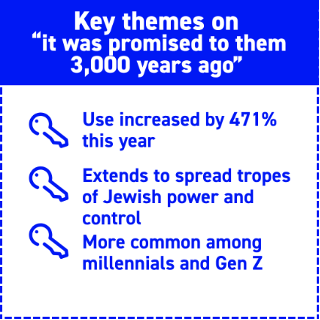Antisemitism has adapted to the language and prejudices of each era, and online today two strains often travel together:
- Racial or “genetic” narratives that deny or demean Jewish peoplehood
- Religious narratives that recast Judaism as evil or conspiratorial
Since October 7, 2023, both have surged. For example, there have been 1.8 million social media mentions discussing genetics in the context of Israel or Judaism—a 188% increase over the prior two years.

For centuries, antisemitism has morphed to fit prevailing ideas. One modern example is the online habit of calling Jewish people “inbred,” an adaptation of older racial pseudoscience that sought to define Jews as biologically defective.
Today, much of the genetic discussion about Jews falls into two broad categories:
- Narratives that deny or delegitimize Jewish peoplehood
- Narratives that depict Jews as genetically inferior.
At the core of both is the same goal: to promote the idea of the so-called “fake Jew” and to strip Jewish identity of its legitimacy.
Social media mentions of “Jews” alongside “inbred”
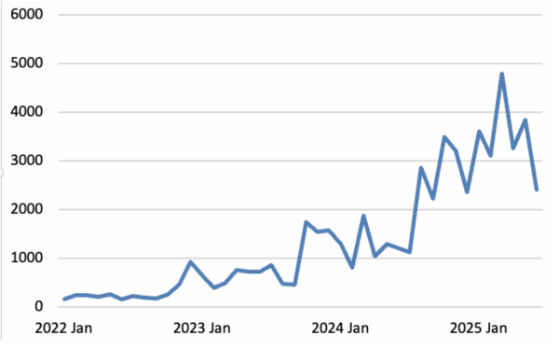
How Genetic Antisemitism Has Evolved Over Centuries
While the rhetoric is updated for the digital age, the underlying ideas are not new. In medieval Europe, antisemitism was driven largely by religion, portraying Jews as spiritually corrupt or heretical. During the Enlightenment Period, through the 19th century, this othering shifted into emerging racial theories that framed Jewish identity as a biological category. Philosophers, such as Voltaire, portrayed Jews as inherently corrupt, greedy, and untrustworthy, and 19th-century race theorists described Jews as a biologically distinct and inferior group.
These ideas laid the groundwork for two persistent strands of modern genetic antisemitism: one that denies Jewish peoplehood and one that assigns Jews inherent genetic inferiority. Today, these themes appear in narratives claiming Jews are “inbred” (inferiority), purely European, or “fake Semites” (denial of peoplehood).
From these racial theories grew damaging myths about Jewish origins. One of the earliest was the Khazar theory, which claims that Ashkenazi Jews descended from a Turkic tribe that converted to Judaism in the Middle Ages, and are therefore not “real” Jews.
While originally proposed as a historical hypothesis, it was later used to deny Jewish ties to ancient Israel. The broader pseudoscience behind these narratives was later weaponized by the Nazis, who relied on racial “science” to define Jews by blood rather than belief, using ancestry charts, skull measurements, and eugenics to justify execution and genocide.

Many of the older conspiracies around Jewish ancestry have persisted nearly unchanged. The Khazar theory, for example, continues to circulate widely online with the same basic message it has carried for over a century. It has been mentioned roughly 150,000 times on social media over the past decade, but saw a significant resurgence after the Hamas attacks in October 2023.
But other narratives have shifted and taken on new forms. Some radical sects of the Black Hebrew Israelite (BHI) movement claim that Black people are the true descendants of the ancient Israelites, while today’s Jews are imposters with no real connection to Judaism.
This “real Jews” narrative reframes Jewish identity as a racial fraud. While these BHI-origin narratives are not among the most widespread conspiracy themes on social media, they have maintained a steady presence in the background since they first began circulating.

Building on these long-standing myths, newer variations have emerged on social media, adapted to current events. One widespread idea is the portrayal of all Jews as white European colonizers, which denies the existence of Sephardi, Mizrahi, and Ethiopian Jews and casts Jewish peoplehood as a tool of Western imperialism. Since October 7, 2023, there have been over 8 million mentions of either “Jew” or “Zionist” appearing alongside “white colonizer,” a 183% increase from the two years prior. In the same period, there was a sharp increase in posts using the phrases “Zionists are Polish” or “Zionists go back to Poland,” reviving arguments that Jews in Israel are of purely European origin.

Genetic Antisemitism Attempts to Distance Jewish Connections to Israel
Another related trend that gained traction after the Hamas attacks in Israel is the effort to “disprove” Jews’ connection to Israel by questioning whether they are really “Semites,” with rhetoric about Jews being “not real Semites” or “fake Semites.” Some posts go further, framing Jews as racially inferior or, in a reversal, as racially superior oppressors, using these labels to justify hostility.
A further extension of these narratives involves pseudoscientific claims, in which commercial DNA testing is misused to argue that Jews lack Middle Eastern ancestry, sometimes combined with conspiracy theories that Israel suppresses genetic research to hide this alleged truth. Unlike other themes, discussion of genetic-testing conspiracies has shown sporadic spikes since October 2023 but not a consistent upward trend.
Social media mentions of “real Semites” or “fake Semites”
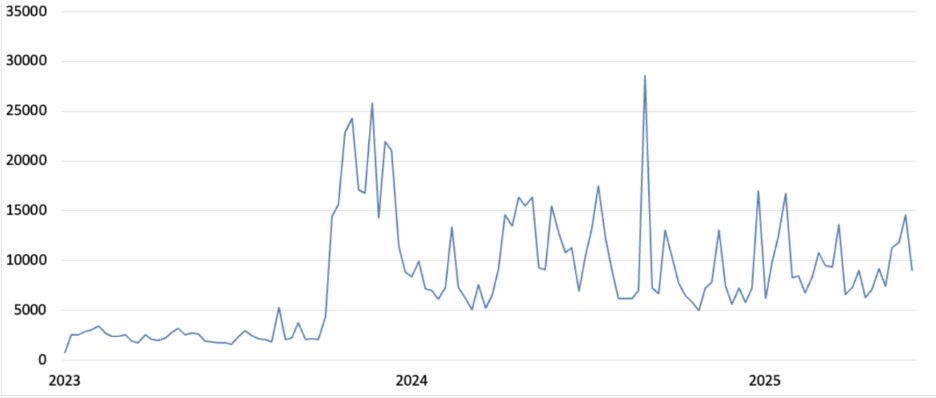
These narratives, whether recycled from old myths or adapted to the politics of today, all work toward the same goal of undermining Jewish identity and legitimacy. By framing Jewish peoplehood as a fraud, antisemites seek to erase history and turn genetics into a weapon. Understanding how these claims evolve is essential to recognizing and countering them before they are normalized and believed as fact.
Religious Antisemitism and how it appears online
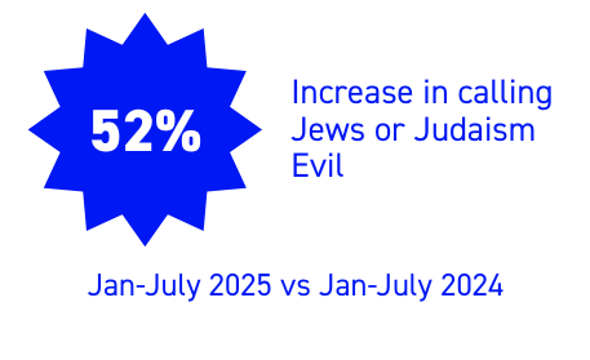
Alongside these racial and genetic frames, one of the oldest forms of Jewish hate is religious antisemitism. Sometimes referred to as theological antisemitism, this prejudice has targeted Jewish beliefs, practices, and sacred texts for millennia. While racial antisemitism rose to prominence in the modern era, culminating in the Holocaust, religious antisemitism stretches back to at least the third century BCE in Egypt.
Today, many of these age-old narratives are being revived and reshaped on social media, echoing centuries-old accusations while adapting to current events. For example, after October 7, 2023, online conversations that likened Judaism to Satan or described it as evil spiked sharply.
Social media mentions calling Judaism evil, Satan, or the devil
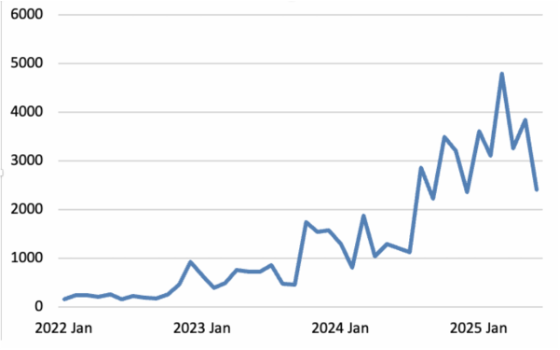
How Does Religious Antisemitism Play Out on Social Media?
Historically, religious antisemitism manifests in multiple ways. The blood libel falsely accused Jews of murdering Christian children for ritual purposes, fueling pogroms and deep societal suspicion. Deicide accusations blamed Jews collectively for the death of Jesus, sustaining centuries of persecution. The “Synagogue of Satan” conspiracy cast Jews as secretive agents of malevolence, bent on corrupting or controlling society. Repeated attacks on the Talmud portrayed Judaism as morally corrupt or subversive—from medieval Christian polemics to Nazi propaganda.
On social media, two persistent tropes are the Synagogue of Satan conspiracy and deicide accusations. The Synagogue of Satan conspiracy, with over 340,000 mentions since October 7th, reappears in comments calling Jews those who “turned their back on Jesus,” branding individuals as “brood of vipers,” or simply labeling Jewish people or videos “Synagogue of Satan”—a more than 300% rise in mentions over the past two years.
Deicide accusations, rooted in New Testament interpretations, are also resurfacing in casual online use. Phrases such as “Jews killed Jesus” appear alongside comments linking this claim to current conflicts in the Middle East. These tropes still circulate widely online, often in their original forms, and whether used as supposed historical fact or as contemporary insult, these statements reinforce the image of Jews as spiritually dangerous.

The blood libel, too, has adapted to modern times. While direct claims of ritual murder are less common, the underlying accusation survives through conspiracy narratives and sensationalized allegations about Israel or Zionists harming others. Online, this appears in comments suggesting a “Jewish ritual need for the blood of Gentiles,” or claiming that Israel kills children and civilians to harvest organs for profit. Such statements, often framed as fact and echoing classic blood libel themes, have contributed to a 322% increase in related conversations since October 7th.

These persistent narratives show how religious antisemitism evolves while keeping its core prejudices. Blending centuries-old accusations with current events, social media amplifies their reach.
Online, antisemitism runs on two engines that feed the same machine: delegitimization and demonization. The racial or genetic frame insists Jews are a fabricated or inferior people; the religious frame insists Judaism is a malevolent faith. On today’s platforms these claims— “proof” about ancestry links to posts that brand Judaism evil—offer a pseudo-scientific excuse and a moral warrant for the same hostility.

